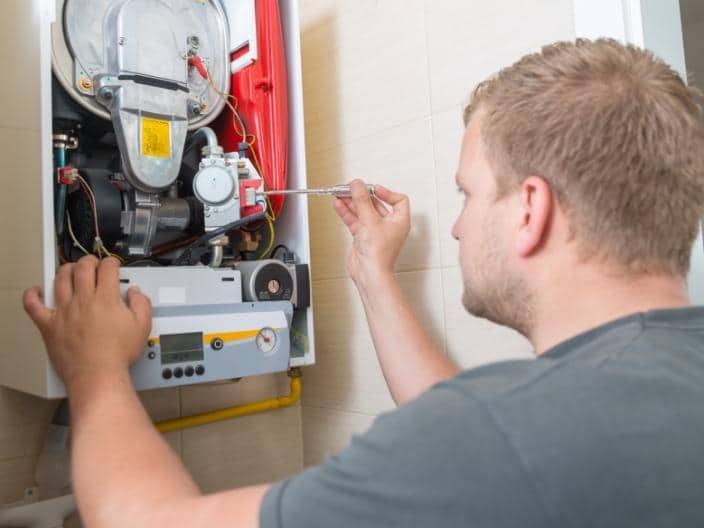
If you are thinking of installing a gas-fired furnace, there are a few important factors to keep in mind. First, it is vital to check with the local permitting department since many places restrict gas line work to licensed technicians. If you are clear to go ahead with the installation, you want to be sure to install a vented door for furnace room safety. Keep reading to learn more.
What Kind of Door Do I Need for a Furnace Room?
Furnace rooms have unique needs, which may affect the type of door you install in them. For example, the combustion process draws air in from the utility room. This air must be replaced with fresh air from outside or within the home. Additionally, it produces exhaust which must be vented safely. You can accomplish this by installing the correct door type in your furnace room or utility closet.
In some areas, building codes may require a particular kind of vented door, often called a louvered door. These doors have small slatted openings in the lower portion to allow exhaust and heat out and draw in fresh air.
Proper ventilation is key to the safe and efficient operation of your furnace or HVAC unit. Licensed HVAC contractors have current information about requirements and recommendations for various systems, and these professionals know which units require vented doors and which ones do not. Reach out to a licensed contractor if you have any doubts about the proper way to install your new furnace.
Wondering what kind of door to put on your furnace room? Check out this article with 5 HVAC Closet Door Ideas That Look Good and Block Sound!
Does a Furnace Room Need a Vented Door?
In short, a furnace room must have a vented door installed. This particular door style allows for greater safety and equipment efficiency. Let’s look at why a furnace room should be vented.
Reasons Why You Should Use a Vented Door for Furnace Rooms
The primary concern is the buildup of potentially harmful carbon monoxide gas caused by combustion. Not only are these fumes dangerous to breathe, but they can also accumulate inside a sealed room and amass to explosive levels. Installing a vented door for utility rooms lowers the likelihood of this happening.
There is also the additional concern about radiant heat put off by a furnace. Even with proper outside venting, some heating units generate significant heat. The heat can build up in an insulated and unventilated utility room and possibly affect the temperature in nearby living areas.
Do HVAC Rooms Need To Be Sealed or Vented?
You may be wondering, “Does HVAC use louvered doors, too?” The answer will depend on what type of HVAC system you are installing. For example, an all-electric heat pump may not need ventilation, whereas if you install a gas-fired system, you want a vented door for utility rooms.
What Is the Difference Between a Vented and a Louvered Door?
Louvered doors are a specific style that allows for ventilation. Some have a small section, usually equipped with louvers or slats on the bottom. Other types feature a frame with louvers on the top and bottom halves. The louvers allow fresh air to enter the room while also allowing heat and gasses to escape.
Do You Need a Louvered Door for a Furnace Room?
Technically, you do not need a louvered door for a furnace room. However, you need a door that provides adequate ventilation and allows for proper temperature regulation. Louvered doors are a simple and attractive way to accomplish this. They are readily available, and installation is the same as with any other interior door.
How Do You Vent a Furnace Door?
There are several ways to vent the door into a furnace room. For example, you can choose to install a new louvered door. A door of this type allows you various setup options, like adding an insulated door to dampen noise from the furnace. It is also an easy way to ensure that the furnace room and ventilation are up to local building codes.
If your furnace room door is in good condition and you do not want to replace it, you can opt to add a vented panel. This only works with certain types of doors, since the panel will need adequate support.
Can a Furnace Be in a Closed Room?
There are some situations where a furnace can be in a sealed room. However, failure to vent a unit when necessary can create a dangerous situation. Contact the manufacturer or a licensed HVAC contractor if you have any doubt about whether your unit needs a vented door to ensure you follow the requirements.
A furnace may not need a vented door if it is directly vented to the outside. When done correctly, this removes potentially dangerous exhaust so it does not accumulate inside the home while providing fresh air to fuel combustion.
Another situation that may allow you to forgo ventilation is when your system runs off electricity. Since electric HVAC systems do not produce exhaust, they do not need a vented door for furnace room entryways. However, if the temperature is a concern in either situation, you may still want to use a vented door for utility room comfort.
How Close to the Door Can a Furnace Be Installed?
If you replace an existing furnace, it can probably go in the same location as your old unit. However, that may not always be the case. Check local codes to determine if your furnace room has sufficient space before purchasing a new one.
You generally want at least 24 inches of space in front of a furnace. This leaves enough room for maintenance and any repairs that your system may need in the future. You also want to leave at least 3 inches between any walls and the combustion air intake.
Can Anything Else Go In a Furnace Room?
Many people use the furnace room for storage or other mechanical equipment. If the room is large enough, this should not be a problem. Many homes have water heaters and similar equipment in the same room as a furnace or HVAC unit.
However, some items should not be placed in a furnace closet. For example, cardboard boxes and flammable items, such as paint or cleaning chemicals, can present a fire hazard. You may also want to avoid putting a refrigerator or freezer in the room since heat buildup may interfere with efficient operation.
Wrap Up
In many but not all cases, you will need to install a vented door for furnace room applications. Louvers ensure heat and exhaust can escape while providing fresh intake air. You must always follow local building codes when installing a furnace.
